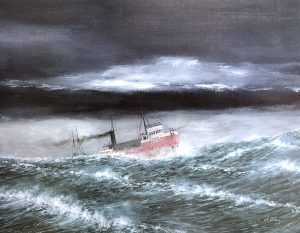You never know when a little bit of history about the Great Lakes might come in handy. Whether you’re just curious or need to finish an assignment on the topic, here are a few key details to know.
The 5 Great Lakes form together the largest connecting area between freshwater sources on the earth. In fact, one of them, Lake Superior, is larger than any other lake in the world. Many talented artists have created nautical artwork reflecting these great bodies of water.
The basins of the Great Lakes were probably formed by glaciers during the ice age. As the glaciers were pushed down from the north, the weight of these pieces of ice created wide valleys. Then, when the water melted, it left behind huge giant rocks and sand, blocking the springs of the valleys. At the same time, as the weight of the ice decreased, the shore began to rise from the southwest direction. That made the surface of the region bend and the water flow from southwest to northeast. As the ice retreated, all the lakes directed their course to the St. Lawrence River and the Atlantic Ocean.
But how come the Great Lakes contain fresh water? They assimilate some water courses, but most rivers avoid the Great Lakes basins. The main water source of the five lakes is underground water, found near the surface, throughout the region. The lakes’ basins are filled by infiltrations and many streams of small springs. The Great Lakes are also like huge drainage places for ponds and rainwater, so they permanently receive a constant source of fresh water.
The area where the Great Lakes are located, but also their canals, has 246 square meters.

Great Lakes Storm of 1913
One of the most significant events in the recent history about the Great Lakes is the storm from 1913, also known as the “Big Blow”, “Freshwater Fury” or “White Storm”. It was a hurricane-like storm that devastated the Great Lakes basin of the United States and the Canadian Ontario area, between 7-10 November, 1913.
The storm`s climax was on November 9, shaking and sinking ships in four of the five Great Lakes, especially in Lake Huron. The capricious storm season, as well as the slow pace of meteorological reports contributed to the extensive storm damage.
Snow storms are quite common on the Great Lakes because cold air from the northern pole collides with the warm air of the Gulf of Mexico. November is a very active month because the water in the Great Lakes is still relatively warm and this contributes to the formation of storms. In addition, polar storms are becoming more and more frequent and intense, as the global warming process progresses.
The big storm from 1913 appeared as a convergence between two major storms fueled by relatively warm lakes – a seasonal phenomenon known as “November gale” that may produce strong wind that sometimes travels with 145 km/ h (90 mph), waves over 35 feet tall (11 m) and snow storms.
The storm remains one of the best-known moments in the history of the Great Lakes; its analysis and its impact on humans led to quicker action, namely preparing and conceiving stronger constructions and marine ships.